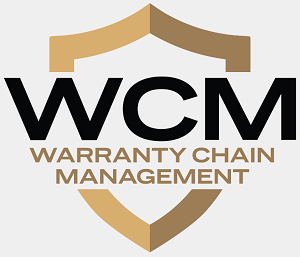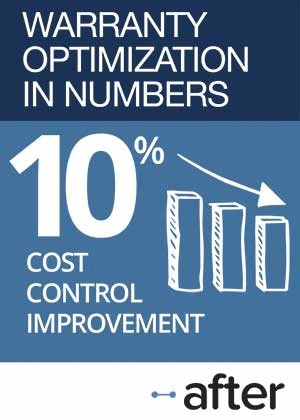Service Contract Insurance Stocks:
While service contract underwriting is only a small part of the insurance industry, it's a large part of the revenue stream of a handful of insurance companies. Here are the stock price and dividend yields of eight of the largest from May 2008 until today.
While there's no such thing as a "pure play" available to the average investor interested in the extended warranty industry, there are a handful of market leaders for which service contracts and protection plans represent a meaningful slide of their overall revenues and profits.
We first began to cover the extended warranty/service contract/device insurance underwriters from an investment point of view back in 2009, a few months after the very bottom depths of the financial crisis were reached. In a May 14, 2009 newsletter, we looked at the stock performance of four insurance companies over a one-year period.
And then in an August 8, 2010 newsletter, we looked at the two-year performance of several additional insurance companies, again starting with their prices on May 14, 2008. Amazingly, through an oversight it's taken us more than five years to realize, we haven't looked at them since.
So this week, as he stock market once again looks like it's becoming unstable (and therefore might be providing some buying opportunities for fearless investors), we're going to check in with eight of the top underwriters of service contracts, extended warranties, home warranties, and mobile phone protection plans. We'll once again look back to May 2008 as our starting point, to keep the comparisons relevant.
CNA Financial Corp.
Let's start with CNA Financial Corp., whose common shares trade on the New York Stock Exchange under the ticker symbol CNA. Through the operations of its CNA National vehicle service contract subsidiary as well as its underwriting of the retail electronics and mobile phone clients of service contract administrator Asurion LLC, CNA Financial may be among the largest underwriters in the entire protection industry.
However, it remains hard to determine exactly how much money changes hands from the sales agents to the administrators to the insurance underwriters. CNA Financial said its "Warranty & Alternative Risks" business brought in $381 million in 2014, up from $350 million in 2013. But that was only its share of a much larger amount of premiums paid by consumers to AT&T, Wal-Mart, Target, and other retailers for product protection plans.
Shares of CNA were priced at $25.80 on May 14, 2008. They closed today at $36.18, representing a gain of roughly 43% over the period (not counting dividends). With a quarterly dividend payment of 25 cents, the stock is yielding almost 2.8% at this time, which in this group is roughly in the middle of the pack.
In Figure 1, we're tracking the stock performance of CNA Financial over the past seven-and-a-half years. As can be seen in the chart, the shares plummeted through the end of 2008 and the beginning of 2009, before bottoming out on March 9, 2009 at a price of only $5.42 per share. In March and April of this year, the stock traded above $40 per share on multiple days -- more than seven times its price during the depths of the financial crisis.
Figure 1
CNA Financial (CNA) Common Stock Price
(US$ per share, 2008-2015)
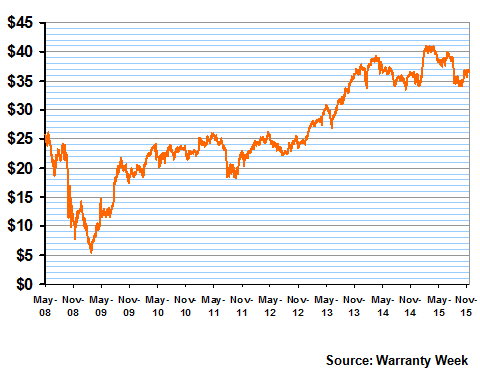
Assurant Reorganizes
Assurant Inc. is another major player in the service contract underwriting business. And like CNA and AmTrust, it has extensive operations in both the vehicle service contract and the retail electronics/appliance sides of the business. One of its most recent wins was the Nexus Protect program recently launched by Google.
Assurant Inc. is comprised of four units: Assurant Solutions, Assurant Specialty Property, Assurant Employee Benefits, and Assurant Health. It is currently in the process of selling its health insurance operations, and should be out of the business entirely by the end of 2016.
Out of the four units, Assurant Solutions is the service contract part of the company. In 2014, Assurant Solutions reported $2.48 billion in net earned premiums for extended service contracts and warranties, of which nearly two-thirds was based in the U.S. "Extended service contracts include warranty contracts for products such as mobile devices, personal computers, consumer electronics, appliances, automobiles and recreational vehicles," the company explains in an accompanying note in its annual report. "Through partnerships with leading retailers, mobile carriers, original equipment manufacturers, and direct to consumer distribution, we underwrite and provide administrative services for extended service contracts and warranties."
Shares of Assurant stood at $58.09 on May 14, 2008. They immediately began to fall as the financial crisis deepened, bottoming out at $14.88 in March 2009. And it wasn't until late 2013 that shares surpassed their pre-crisis level. Then they took a pause in the sixties for a while as the company contemplated its reorganization, before resuming their climb in May of this year.
Shares of Assurant closed at $82.99 today, down almost two percent roughly two weeks after hitting a new high of $86.99 per share. With a dividend of 50 cents per quarter, the yield at the present time is just over 2.4%, which is in the middle of the group.
Figure 2
Assurant (AIZ) Common Stock Price
(US$ per share, 2008-2015)
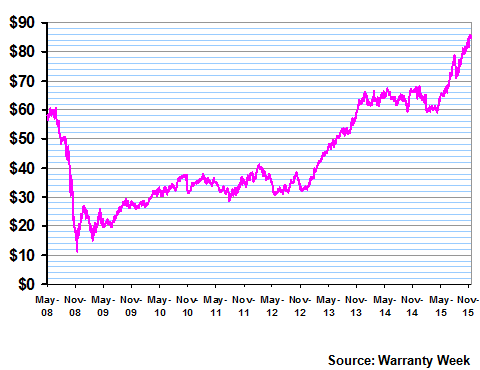
AmTrust Soars
AmTrust Financial Services Inc., a longtime sponsor of this newsletter, is another major player in the service contract industry. Through both its own administrators such as AMT Warranty Corp. and Warrantech (acquired in 2010), as well as through third party administrators, it controls a growing slice of the brown goods, white goods, and automotive sectors of the service contract industry.
In 2014, out of a total of $6.09 billion in gross written premiums, the Specialty Risk and Extended Warranty segment accounted for $1.98 billion, or nearly a third of the company. Workers' compensation insurance and other commercial property and casualty insurance lines comprised the rest. But there is no information on how much of that is specialty risk (e.g. legal expenses in the event of unsuccessful litigation; property damage for residential properties; and latent defects that materialize on real property after building or completion) and how much of it is extended warranty. However, the segment is growing at a 31% annual rate.
Despite a whisper campaign conducted by short sellers, the company's stock continues to appreciate in price. Short sellers, who borrow shares from other stockholders and then sell them in the hopes that they will then fall in price, have taken a beating as a result. As can be seen in Figure 2, shares have risen at an increasingly steeper rate for most of the past seven years.
In May 2008, AmTrust shares stood at $11.16. Today they closed at exactly $62.00 each. That's more than five times as much as they cost back then. In March 2009, however, they almost dipped under $5.00 per share, as investors hit the panic button.
With a current dividend of 30 cents per share per quarter, anybody brave enough to have bought shares of AFSI at the low point would now be enjoying a yield over 23%. However, anyone who bought the shares at the all-time high price of $71.87 that they briefly hit in early August would be enjoying a yield of only 1.7%. So it's all a matter of timing.
Figure 3
AmTrust (AFSI) Common Stock Price
(US$ per share, 2008-2015)

AIG Recovers
American International Group Inc., better known as AIG, is a victim of timing. Only days after the U.S. government said "no more bailouts," allowing Lehman Brothers to go bankrupt and thereby seizing up the world's financial system, AIG had to be bailed out by that same U.S. government. The penalty was severe, essentially wiping out equity investors as the government took control of almost 80% of the company.
Adjusted for subsequent reverse stock splits, the price of AIG common stock on May 14, 2008 was $629.84 per share. By Sept. 15, 2008, they were down to $77.21 per share. In early March 2009, they slipped under $6.00 per share.
It's therefore pointless to include a chart of AIG share prices from May 2008 until now. Instead, what we've done in Figure 4 is to chop off six months of data, so the chart begins on Nov. 14, 2008 -- almost two months after the company fell into the hands of the U.S. government.
In spite of the parent company's crisis, AIG Warranty and its primary underwriter, the Illinois National Insurance Co., held onto several major customers, such as Best Buy, and added some major new clients, such as Apple's AppleCare+ program (for accidental damage coverage). And its wholly-owned administrator, now known simply as Service Net, continues to excel in product sectors such as personal computers and HVAC systems.
As can be seen in the chart below, there was quite a bit of volatility for a few years before AIG began a steady recovery in late 2011. The per-share price is now back up to $62.36 as of today's close, but that's less than a tenth of their pre-crash price.
One reason for the continued uptrend is the reintroduction of a quarterly dividend in 2013, following the re-acquisition of the U.S. government's shares. Now up to 28 cents per quarter, the dividend represents a 1.8% return for current buyers. However, anyone brave enough to buy them when the world was ending in March 2009 would now be looking at a return just under 20%. Then again, anyone who held onto their shares through the collapse (hello, Hank Greenberg) would have a yield under 0.2% and would still be missing more than 90% of their original equity value.
Figure 4
AIG Inc. (AIG) Common Stock Price
(US$ per share, 2008-2015)

Comparing the Four
In Figure 5, we're comparing the per-share prices of these four market leaders as if they all ended at 100 on May 14, 2008. At that scale, an index value of 200 would represent a doubling of the initial price, an index value of 500 would represent a quintupling, and so on.
It's pretty obvious that of these four, AmTrust would have been the best buy back in May 2008, with a recent index value of 570. AIG would be the worst, with an index value of only 10.2. CNA is at 143 and Assurant is at 147.
For current share buyers, CNA represents the highest yield, at 2.8%. Next comes Assurant at 2.4%, followed by AmTrust at 1.9% and AIG at 1.8%. As we shall see, some of the additional four companies outlined below have substantially higher dividend yields.
Figure 5
Four Insurance Stock Prices Compared
(May 14, 2008 = 100)

Allstate Protection
The Allstate Corp., through Allstate Dealer Services, the First Colonial Insurance Company, and Pablo Creek Services Inc., has a major stake in the vehicle service contract industry. These operations are included within the Allstate Protection segment, which is dominated by private passenger auto and homeowners insurance sales. Auto premiums written totaled $19.67 billion in 2014, and Allstate-brand homeowners premiums written totaled $6.54 billion last year.
According to the company's latest annual report, "Other business lines premiums written," which includes Allstate Dealer Services, totaled $717 million in 2014. The company doesn't specifically say how much of that was VSC, but it does say that most of the unit's 19% growth from 2013 to 2014 was "primarily due to increased sales of vehicle service contracts at Allstate Dealer Services."
In May 2008, shares of Allstate stood at $40.75, but they fell for months to a low of $11.86 in early March 2009. They recovered back into the twenties for the next two years, before beginning a climb in 2011 that lasted until April 2015, when the stock peaked at $71 per share. With a current stock price of $62.77 per share and a dividend paid at a rate of 30 cents per quarter, the company's yield is a little over 1.9%.
Figure 6
Allstate (ALL) Common Stock Price
(US$ per share, 2008-2015)

Autos & Homes
Old Republic International Corp. is on our list for two reasons. On the vehicle service contract side, the company owns Old Republic Insured Automotive Services Inc. (ORIAS), and on the home warranty side, it owns Old Republic Home Protection Co. Inc.
Old Republic's General Insurance Group includes what it calls automobile extended warranty insurance, as well as home warranty insurance. In 2014, the amount of net premiums earned by the home and auto warranty operations stood at $213 million, or roughly 7.8% of the Group's total net premiums earned. The much bigger slices of the pie include workers' compensation insurance and truck insurance. Old Republic also has a relatively large title insurance operation.
Old Republic shares stood at $9.56 apiece in May 2008, but during the financial crisis they spiked as high as $10.91 and fell as low as $5.08 per share. The stock spent most of the next three years stuck in a trading range before breaking out in 2012. And then it hit another plateau in 2014 before resuming its climb this year. Old Republic shares closed today at $18.52. With a quarterly dividend rate of 18.5 cents, that results in a yield just a hair under 4.0%.
Figure 7
Old Republic (ORI) Common Stock Price
(US$ per share, 2008-2015)
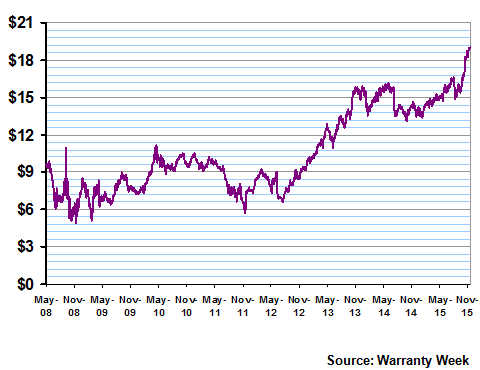
We Are Farmers
Zurich Insurance Group AG is the only non-U.S.-based insurance company on our list, but the stock we're tracking is actually the U.S. representation of that Swiss stock: an American Depositary Receipt (ADR). As such, while it reflects the Swiss price of Zurich shares, it also is affected by U.S. dollar-Swiss franc exchange rate fluctuations.
Zurich is likely to not be as familiar to many Americans as some of its subsidiaries. For instance, the company has owned the Farmers Insurance Group since 1998, when it acquired B.A.T. Industries plc, which acquired Farmers in 1988. Farmers, in turn, acquired in 2009 a company called 21st Century Insurance and Financial Services Inc., which writes mechanical breakdown insurance policies in addition to more traditional auto insurance.
But Zurich's involvement in the extended warranty and service contract industry runs much deeper than just that. It also owns or is affiliated with American Guarantee and Liability Insurance Co.; American Guarantee and Liability Insurance Co.; American Zurich Insurance Co.; Colonial American Casualty and Surety Co.; and Universal Underwriters Insurance Co.
As underwriters, these companies are heavily involved in the vehicle service contract industry, and now, through both Leap Wireless and Sprint's eSecuritel, in the mobile phone protection business.
Universal is the underwriter for one of the largest VSC administrators of all: APCO Holdings Inc., which markets the EasyCare brand. Also known as APCO or the Automobile Protection Corp., the company was part of the Ford Motor Company from 1999 to 2007. APCO was recently sold by Stone Point Capital LLC to the Ontario Teachers' Pension Plan.
Zurich also used to own a stake in the joint venture GE-Zurich Warranty Management Inc., before selling it to General Electric Co., which in turn sold it to Assurant Inc.
Zurich's ADR shares stood at an even $19 per share in May 2008. They briefly dipped below $7 per share in March 2009 before beginning a bumpy climb through the teens and twenties. From late 2014 through mid-2015 the shares traded mostly above $30. As of today, they trade at $25.97. With an annual dividend most recently set at $1.79 per share, the yield is almost 6.9%.
Figure 8
Zurich Insurance (ZURVY) Common Stock Price
(US$ per share, 2008-2015)

One More Underwriter
Mercury General Corp. is the smallest insurance company we're tracking, with $2.8 billion in net premiums earned in 2014. Most of that was personal automobile insurance, and most of those policies were written in California, where the company is based. But the company also offers mechanical breakdown protection plans, which is what an insurance company calls vehicle service contracts when it offers them through its own affiliates or subsidiaries. It's a relatively small slice of their business, but it earns them a slot on our list of underwriters.
"Sometimes referred to as an extended warranty, Mechanical Breakdown Protection plans cover the cost to repair your vehicle when it breaks down," the company states on its website. "Mercury offers a variety of plans from which to choose, including our Platinum Plan, which covers virtually all of your vehicle's mechanical and electrical components. These plans are available for both new and pre-owned vehicles and they often cost hundreds less than other extended warranties."
Mercury common stock started out on May 14 at a per-share price of $32.73. It bottomed out in March 2009 at $15.39 a share before mounting a recovery that continued until late 2014, when the stock briefly topped $60 per share. It closed today at $50.91 per share. With a quarterly dividend of 61.8 cents per share, the stock is currently yielding a relatively generous 4.86%.
Figure 9
Mercury General (MCY) Common Stock Price
(US$ per share, 2008-2015)

Four More Comparisons
When we take the shares of these four companies, and index them so that their closing price on May 14, 2008 is set to equal 100, we get the result charted in Figure 10. As can be seen, all four closely track one another, although at times Old Republic outperformed and Allstate underperformed their peers.
In recent months, Old Republic has resumed its outperformance, but now Zurich is underperforming. Allstate and Mercury General are closely aligned at index values of 156 and 159, respectively. Old Republic is at 199 while Zurich is at 138.
In other words, if you bought all four stocks on May 14 and took your dividends as cash payments, your investment in Old Republic would have nearly doubled, while Zurich's gain would be just under 40% while Mercury General and Allstate would be up nearly 60%.
Figure 10
Four Insurance Stock Prices Compared
(May 14, 2008 = 100)
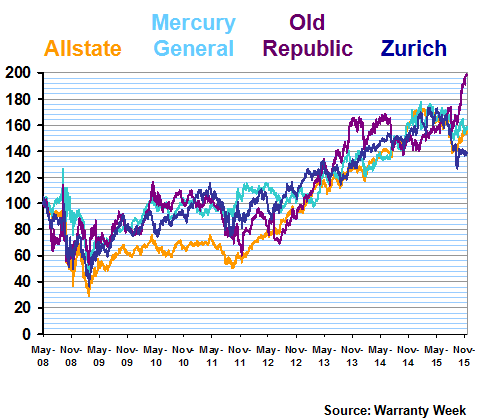
More Underwriters
A few industry giants are missing from our list. The Warranty Group, and its primary insurance company Virginia Surety Co. Inc., remains privately-held by an investment company. Another still-private company is Helios Financial Holdings Corp., majority owner of DAC Financial Holdings Inc., which in turn owns the Dealers Assurance Company.
Protective Life Corp. was acquired earlier this year by the Dai-ichi Life Insurance Company Ltd., a Tokyo-based life insurance company. Warranty Solutions, which was passed like a hot potato from GE Credit to Wachovia to Wells Fargo during the depths of the financial crisis, has finally found a happy home at AmTrust. The Colorado-based administrator owns Heritage Indemnity Company, which continues to underwrite vehicle service contracts sold by auto dealers. JM Family Enterprises Inc., in whose name the JM are the initials of the late founder Jim Moran, remains a family-owned conglomerate of dealerships, service companies and insurance companies.
There are several home warranty companies American Home Shield whose parent company's shares are traded publicly, but whose offerings do not seem to involve an admitted insurance carrier. While they may be worthy investments, they're not insurance companies. And then there are some additional manufacturer-controlled or retailer-controlled "captive" insurance companies, and a handful of smaller privately-owned or foreign-owned insurance companies involved in the business as well.





